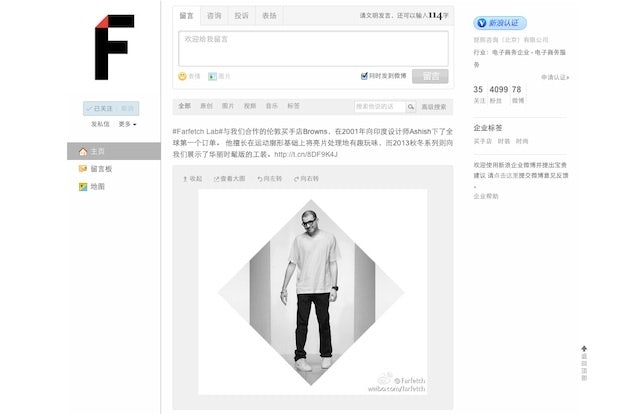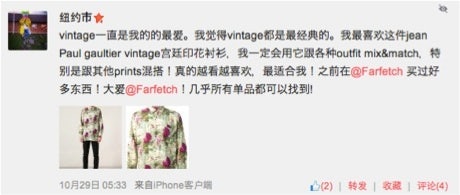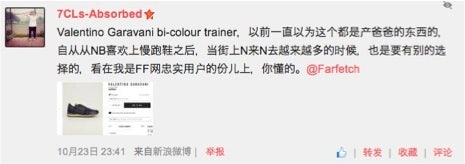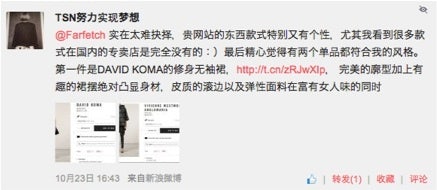
Ever since I first set foot in China in 1999, it seems that global brands have constantly been asking the same question—is China ready for us?
For the best part of the last decade, luxury remained the rarified domain of the moneyed elites—a sector dominated by logo-heavy, high-gloss brands acting as a vehicle for ostentatious shows of wealth.
Increasingly however, pioneering brands have created and profited from the new niche of accessible luxury, or “masstige”, fitting with the aspirations of the increasingly affluent middle classes. On the back of success by players like Coach, many luxury brands are faced with the worrying task of repositioning by offering new lines to appeal to this rapidly rising new consumer.
Exactly what form of luxury holds sway in today’s China and what indicators are there for the future?
Enter Farfetch#
Farfetch is an online hub that brings together more than 290 independent designer boutiques, from Paris, New York, and Milan to Bucharest, Helsinki, and Honolulu. Farfetch not only offers well-known designer brands, but also presents selections of niche labels and vintage designer wear, curated by buyers at select shops worldwide.
As many of the designers on offer are still up-and-coming, even in their home markets, it is hard to imagine a less standard luxury offering for China. Hence the perennial question is valid here—is China ready for players like Farfetch?
Testing market potential via social media#
Hot Pot Digital recently launched the official Sina Weibo account for Farfetch with three core goals: test sentiment in the Chinese market, increase awareness of Farfetch’s offerings, and ultimately drive revenue in this new market. The results were overwhelmingly encouraging.
Within two weeks of launch, and on the back of a targeted campaign, Farfetch had already garnered an impressive 3,500 fans on the platform. While not representing the vast fan numbers of major global luxury brands (many of which are artificially bolstered with computer-generated fake fans) Farfetch’s rapid rise to this number of real, active, and engaged fans offers an early proof of concept for both Farfetch and the boutique store niche.
Growing fan numbers and a nearly 100 percent active fan ratio are excellent indicators, but perhaps more encouraging for Farfetch’s future potential in China are the quality of the interactions and comments which give insights into the savvy target consumer.

Translation: “Vintage has always been my favorite. Love this Jean Paul Gaultier vintage shirt—I would mix and match with other prints. Farfetch has everything I dream of.” (Sina Weibo)

Translation: “Everyone wears the same types of trainers, like New Balance, so I chose something different: a Valentino Garavani trainer from Farfetch.” (Sina Weibo)

Translation: “Farfetch is so special, I found something that can’t be found in domestic stores in China. This piece has a great shape, creating an attractive silhouette." (Sina Weibo)
It seems that for today’s elite in China, shows of wealth have been replaced with shows of understanding.
Naturally, not every consumer in China is a potential Farfetch customer, but a tailored content and KOL strategy has allowed Farfetch to reach exactly the right audience—i.e. those who “get” the brand, are excited by the product offering, and have the highest potential for conversion into sales.
What factors have driven this success?#
The key attraction of Farfetch and other less mainstream luxury offerings can be summarized in a single word: individualism.
In China, identical LV bags can now be found on every street corner from tier one right through to tier four cities. By contrast, Farfetch recently released a collection of fifty unique Jean Paul Gaultier vintage pieces from the vaults of London boutique House of Liza. For a demographic that is looking to stand out from the masses, the appeal of this one-of-a-kind luxury is not hard to fathom.
Perhaps the most exciting aspect of the Farfetch launch is that its benefits have already been felt beyond the realm of social media. The Weibo campaign delivered a boost to Farfetch’s China web traffic as well as driving valuable sales directly from Weibo to website and ultimately to checkout.
In a sphere where many brands content themselves with pure fan numbers as a measure of Weibo success, seeing tangible financial benefits so early in the campaign lifecycle is a great indicator of future potential for Farfetch in the Chinese market.
What this means for the future of fashion/luxury#
Is China ready for a wide array of labels, designers and boutiques, no matter how niche? Based on this drive towards a more personal, individualized form of luxury, it seems that the answer is a resounding yes.
Knowing and targeting today’s sophisticated consumer is vital to ongoing success for luxury brands in China. By tailoring a suitable content strategy and delivering reach via hand-picked KOLs, brands not only ensure immediate engagement and sales but also drive crucial long-term affinity.
Jonathan Smith is Managing Director of Hot Pot Digital, a 100 percent China-focused social media agency based in London, Beijing, and Shanghai. Hot Pot Digital handles China digital strategies for leading global luxury brands and retailers including Mulberry, Ted Baker, and Farfetch. Follow @HotPotDigital on Twitter.